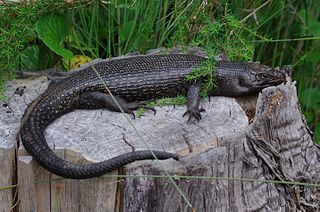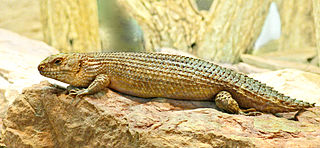
Egernia is a genus of skinks that occurs in Australia. These skinks are ecologically diverse omnivores that inhabit a wide range of habitats. However, in the loose delimitation the genus is not monophyletic but an evolutionary grade, as has long been suspected due to its lack of characteristic apomorphies.

Cunningham's spiny-tailed skink, also known commonly as Cunningham's skink, is a species of large skink, a lizard in the family Scincidae. The species is native to southeastern Australia.

The spiny-tailed monitor, also known as the Australian spiny-tailed monitor, the ridge-tailed monitor the Ackie dwarf monitor, and colloquially simply ackie monitor, is an Australian species of lizard belonging to the genus of monitor lizards (Varanus).

King's skink is a species of skink, a lizard in the family Scincidae. The species is endemic to Australia.

White's skink, also known commonly as White's rock skink, is a species of lizard in the skink family. It was first described in 1804 by French naturalist Bernard Germain de Lacépède. It is endemic to Australia.

The black-headed monitor or black-tailed monitor is a relatively small species of monitor lizards native to Australia. It is occasionally also called the mournful monitor, freckled monitor or the racehorse monitor, a name it shares with the Gould's monitor due to their exceptional speed. It is placed in the subgenus Odatria.
The Western Pilbara spiny-tailed skink is a species of large skink, a lizard in the family Scincidae. The species is native to the Pilbara in northwestern Australia.
The Eastern Pilbara spiny-tailed skink is a species of large skink, a lizard in the family Scincidae. The species is native to the Pilbara in northwestern Australia.

Egernia stokesii is a gregarious species of lizard of the Scincidae family. This diurnal species is endemic to Australia, and is also known as the Gidgee skink, spiny-tailed skink, Stokes's skink and Stokes's egernia. The species forms stable, long-term social aggregations, much like the social groups seen in mammalian and avian species. This characteristic is rarely found in the Squamata order, but is widespread within the Australian subfamily of Egerniinae skinks. Populations of E. stokesii are widely distributed, but fragmented, and occur in semi-arid environments. There are three recognised subspecies. The conservation status for the species is listed as least concern, however, one subspecies is listed as endangered.

The tree-crevice skink or tree skink (Egernia striolata) is a species of skink, a lizard in the family Scincidae. The species is endemic to Australia and is found in the states of Victoria, the Northern Territory, Queensland, New South Wales and South Australia. E. striolata tend to live in crevices and cracks in hollow logs or rocks. They greatly prefer heterogeneous and structurally diverse habitats and their behavior changes depending on the habitat they live in.

Hosmer's spiny-tailed skink, also known commonly as Hosmer's egernia and Hosmer's skink, is a species of large skink, a lizard in the family Scincidae. The species is a diurnal, rock-dwelling species native to Northern Australia.

The black rock skink is a species of large skink native to Eastern and Southern Australia from central New South Wales to Grampians National Park in Victoria. A large, dark colored skink, up to 135 mm from snout to base of the tail, the black rock skink is the first reptile discovered to have a "nuclear family" structure where the parents form a pair and care for their offspring for more than one year. The black rock skink is a viviparous skink meaning females give birth to live offspring instead of laying eggs. They defend their home range and families against conspecifics for up to several years.
Egernia douglasi, also known commonly as the Kimberley crevice-skink, is a species of lizard in the family Scincidae. The species is endemic to Australia.
The central pygmy spiny-tailed skink is a species of large skink, a lizard in the family Scincidae. The species is native to western Australia.
The bright crevice-skink is a species of large skink, a lizard in the family Scincidae. The species is native to South Australia and Western Australia.

The desert egernia, unadorned desert-skink or desert skink is a species of skink, a lizard in the family Scincidae. The desert egernia is endemic to the continent of Australia, and is widespread, with populations recorded in all mainland states and territories except the Australian Capital Territory. The desert egernia is found in dry, desert areas with deep, uncompacted sandy/loamy soils and little significant vegetation cover.

The bull skink, southern sand-skink or southern heath skink is a species of terrestrial skink, a lizard in the family Scincidae. It is one of eleven species within the Liopholis genus.
The ghost skink is a species of skink endemic to Australia.
The Spinifex slender blue-tongue or Samphire slender bluetongue is an endemic species of skink that inhabits the arid areas of central Australia. The Spinifex slender blue-tongue is closely related to the large blue-tongue skinks. However is individually categorised under the Genus Cyclodomorphus and species Cyclodomorphus melanops(C. melanops).














